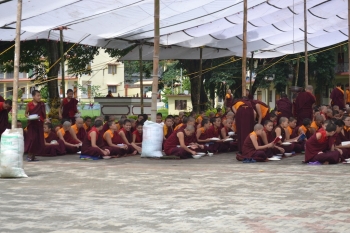he or she feels safe within boundaries will he or she be at liberty to be creative. As the child grasps more concepts, creativity is nurtured and the child is able to make more meaningful connections and express them in an increasingly sophisticated and nuanced manner. Without structure, security and focus, the child is at a loss and enters into a psychological and creative wasteland.
For the very same reason, meditation needs to be focused, meaningful and built upon in maneageable stages. It is not through the obliteration of feelings and judgement but through mindful confrontation that we can eventually train our minds to disengage with distractions. This mindfulness can mean complex visualisation techniques that ultimately help to “sustain” the unsustainable loss of weight, space and time that occurs in meditation. We cannot expect to plunge immediately into a feeling of profound contemplation or have a sudden mystic experience. What we can hope to work towards at first is a simple awareness of the human condition and a state of presence in everydayness.
In meditation, reality does not disappear. Rather, we place ourselves outside our experience, looking upon it with a stereopticon view or a reducing glass. However we paint the larger picture, we remain in it but it is no longer something we command. Instead with meditation, we becomeneither masters nor servants, but elements of what we survey. We find ourselves carefully observing our thoughts to see where they come from. They arise and pass, sometimes sharp and precise, or even diamond-like in their clarity. At other times they are hazy, as the principle of a feeling that cannot be entirely revealed. Thus, rather than retreating from reality, our mental presence in everyday life is heightened with the depth of reality itself. With this, practical benefits naturally arise for our attention skills and creativity. It enables us to break away from habitual behaviours and cyclical patterns of negative thoughts. Particularly important in the Vajrayana tradition is the idea that good and consistent meditation will lead us to become more mindful in daily life. Hopefully, we will extend this application of spiritual practice to our day-to day activity and social interactions, from listening and communicating to cooking, drinking and eating. This comes when we learn to leave our mind at peace, to allow it to settle and not be ruled by the possession of emotions and thoughts.
There is a false expectation that at times of high stress, meditation can be offered up as an instant remedy that can almost immediately lead to a sense of inner calm and well-being. However, meditation is not something to be done as a quick fix. The fruits of meditation practice take time to harvest and bear the natural relation between an individual and the product of his or her labour. It is only after genuine commitment that we can begin to expect to reap its effects and helpful qualities on body and mind. It is these long-term impacts of training the consciousness that will be the true marker of the success of an individual’s meditation practice and the peace so many of us desire.















